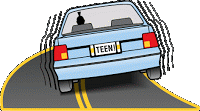Three Things to Consider before Giving Car Keys to Your Teen
Posted in Parenting on 12/07/2015 02:43 pm by CCObtaining a driver’s license is a rite of passage to which many American teens look forward. As parents of a house full of teens, we knew that we’d be called upon at sooner, rather than later, to do our duty in helping to add to the number of teen drivers on the roads.
In the spring of 2014, our then-16-year-old son was excited about getting his driver’s license. However, there were a few things that needed to be done before he could be let loose and trusted to operate a vehicle without supervision.
In our state, before a teen can attempt the road test to obtain a license to operate a motor vehicle, he or she must:
- Pass a written road rules and signage test

- Take 24 hours of classroom training
- Spend 8 hours behind the wheel with a driving school instructor
- Spend 50 hours behind the wheel with a parent or guardian (10 of those hours must be nighttime driving)
Our teen successfully completed all of the requirements, and subsequently, took care of scheduling a road test. When test day arrived, we all drove to the testing site in two vehicles: the one that we bought our teen a few months prior, and one of our other vehicles. Having our son take the test using his own car helped to alleviate potential test stress related to operating an unfamiliar vehicle.
When he drove away with the motor vehicle bureau’s test employee, I prayed – fervently! I prayed for his safety, I prayed for him to remember what he’d learned about driving, and I prayed for him to pass the exam. Then we all waited. Those were some of the longest…minutes…ever!
Finally, when our teen made it back to the lot, we all rejoiced outside of the testing site when he gave us a thumb up and flashed a huge smile. He did it!

We giddily discussed his testing experience as we waited in line for him to get his next driver’s license – the one that didn’t have “temporary” on it. Besides my newly-licensed teen, no one was more ecstatic than I was about his newfound freedom. I was no longer his taxi service. Yay, me!
After the new license was obtained, we watched our teen step into his car and drive home. We drove behind him, I prayed even more, but then he went off course and took the highway home. That wasn’t part of the plan, but he made it home OK.

We had done all that was required to get our teen road ready. We registered him for driving school, helped with driving lessons, bought a car for which we made him pay a portion of the purchase amount, insured our teen driver and his vehicle (at his expense), and discussed driving expectations. However, once the honeymoon period was over, we were faced with the fact that those things are just pieces of the driving puzzle.
Don’t be taken off guard like we were. Before the new-driver honeymoon period sets in for your family, consider implementing the following tips.
Tip #1 – Set Driving Expectations
Discuss your family’s expectations of your new driver, put them in writing, and have all involved parties sign a driving contract. Here are a few dos and don’ts that you may want to discuss and add to your contract:
- Do adhere to driving curfews (Our state has reasonable driving curfews for teens, so we didn’t need to rewrite the book
- Do limit the number of passengers
- Do practice safe driving habits, always
- Don’t drive aggressively
- Don’t use a phone while driving (If a phone call must be made, pull over to a safe place and put the car in “park” first.)
Of course, these common-sense rules apply most families, but your family’s rules should be based on your teen’s required boundaries. You may find that you’ll have to make a “No driving out of town” rule for your teen, or a “Don’t drive it ‘til the wheels fall off” rule, which leads me to the next tip.
Tip #2 – Require Completion of a Basic Vehicle Maintenance Course
There are times during which your teen will be driving and you won’t be immediately available to help him or her out of a bind. Therefore, unless you don’t mind having your teen sitting on the side of the road, you should insist that he or she knows how to:
- Add fuel to the tank
- Change a tire
- Inflate a tire
- Light emergency flares
- Measure how much oil is in the vehicle
- Read and interpret dashboard warning lights
- Use jumper cables
If you’re not knowledgeable enough to teach these things yourself, or if your teen prefers to obtain information from anyone other than parents (we’ve all experienced this), find a local vehicle maintenance class, make use of online tutorials (teens love web-based tools), or recruit a friend or family member to help teach these valuable lessons.
We also encouraged our teen to read his vehicle’s operating manual, but we’ll make this a requirement for our next teen driver. NOTE: Sometimes, parents (present company included) learn the hard way that we need to use the word “must” instead of “should”.
Tip #3 – Keep up with Scheduled Maintenance and Necessary Repairs
Our teen simply hops into his car, adds fuel when needed, and drives all over town with no concern about brake health, battery level, oil condition, tire pressure, or even how to contact our roadside assistance provider.
In frustration, after a flat tire, a missed oil change, and a dead battery (twice), we finally had to give our teen a deadline to take care of his car’s concerns. Our expectations now state that if maintenance and repairs aren’t adequately addressed by given deadlines, the keys will become parental property.
We believe that it’s better for our teen driver to learn how to properly care for his vehicle while he’s still at home, instead of having to suffer preventable breakdowns while away at college.

CC
What are your teen driving tips? Please share in the comments section!
This blog was inspired by personal events. For more teen driving tips, visit TeenDriving.com.


